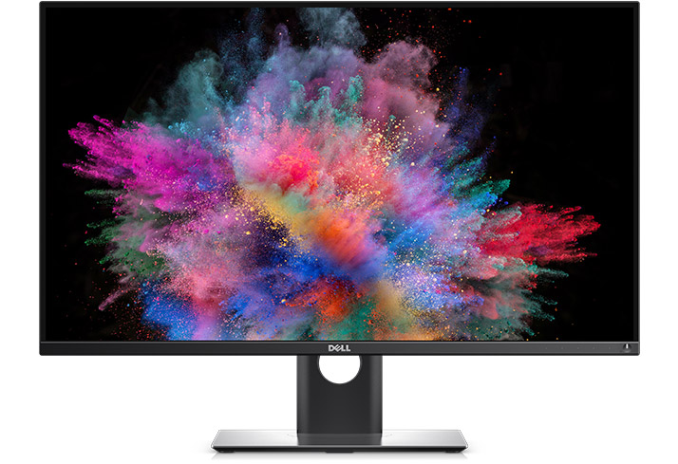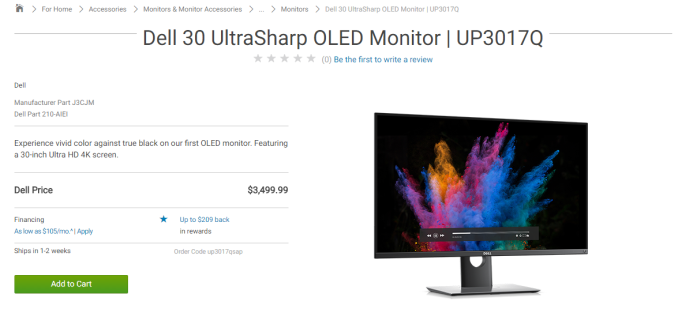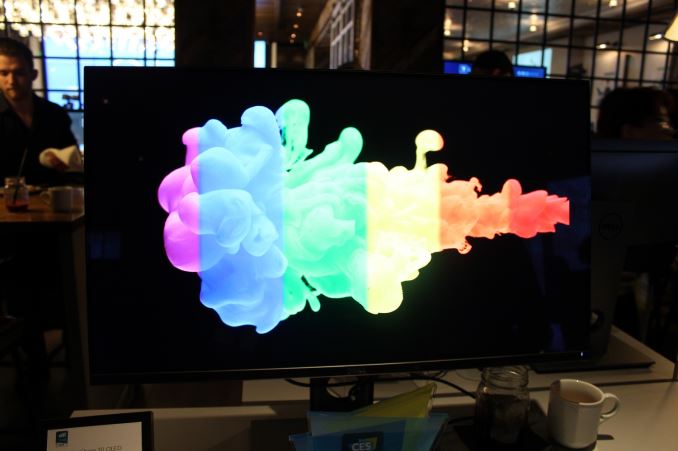Dell’s Ultrasharp 30-inch 4K OLED Now On Sale: UP3017Q for $3500
by Ian Cutress & Brett Howse on April 13, 2017 3:00 AM EST
One of the biggest bits of news to come out of CES 2016, over a year ago, was Dell announcing a new beacon in OLED monitors: a 3840x2160 panel measuring 30-inch diagonal using an OLED display was set to come to market. When we reported on it back at CES, they stated a $4999 price point for March 31st. What happened over the next 12 months was interesting: some journalists doing ‘hands-on’ reviews at tech shows, but nothing coming to retail, followed by plenty of CES 2017 news that the display had been shelved due to image quality issues. Well roll around another quarter, and it seems that Dell is ready to sell it, and shipping for this $3499 beast is only 1-2 weeks away.
| Specifications of the Dell Ultrasharp UP3017Q | |
| UP3017Q | |
| Panel | 76.19cm (30-inch) |
| Native Resolution | 3840 × 2160 |
| Maximum Refresh Rate | 60 Hz |
| Response Time | 0.1 ms (black to white) |
| Brightness | 300 cd/m² (typical) 0.0005 cd/m² (minimum) |
| Contrast | 1000000:1 |
| Viewing Angles | 178°/178° horizontal/vertical |
| Pixel Pitch | 0.1713 mm² |
| Pixel Density | 147 ppi |
| Display Colors | 1.07 billion |
| Color Gamut Support | Adobe RGB: 100% Rec 709: 100% DCI-P3: 97.5% Rec2020: 85.8% |
| Stand | Tilt (5~21°), pivot (+90°, -90°) and height (100 mm) adjustable |
| Inputs | 1 × DisplayPort 1.2 1 × HDMI 2.0 1 × USB Type-C (DP 1.2. PD 100W). |
| Audio | None |
| Launch Price | $3499 |
The Dell UltraSharp UP3017Q is a 30-inch display with a 3840×2160 resolution, response time of 0.1ms, and is set to run at 60 Hz (not 120 Hz as some outlets originally reported). The monitor can reproduce 1.07 billion colors (in this case we assume 10-bit), it covers 100% of Adobe RGB color space as well as and 97.8% of DCI-P3 color space (used for digital movie projection by the U.S. movie industry and is expected to be adopted in televisions and in home cinema), and 85.8% of Rec2020. The manufacturer declares a 1,000,000:1 dynamic contrast ratio, due to the characteristic black of OLED displays.
The UltraSharp UP3017Q is a thin monitor with narrow bezels, but not remarkably thin like OLED TVs, due to the internal power supply unit as well as complex logic inside. The monitor features a mini DisplayPort (mDP) 1.2 connector, an HDMI 2.0 port, and a USB type-C port which can be used for video and data connectivity, as well as power delivery up to 100W.
The Emissive electroluminescent layer in an organic light-emitting diode is made of an organic compound that emits light in response to an electric current. The organic semiconductor layer is situated between two electrodes and does not require a backlight. As a result, it can display deep black levels unlike LCD panels which also use various kinds of backlighting. Curved TVs and monitors are also possible, since the emissive electroluminescent layer is very thin and can take different shapes.
While OLED technology can deliver deep blacks, high contrast ratio and exceptional colors, it is not free of drawbacks. Colors can shift over time, and the organic layer may degrade over prolonged amount of time. To keep the lifespan of the OLED panel maximized inside the UltraSharp UP3017Q, Dell originally advertised a special integrated presence detector into the front panel of the display, which switches the monitor off when nobody uses it, though it is not clear if this is still present. Another disadvantage of OLEDs is a possibility of static image burn-in. The UP3017Q has a special pixel-shifting technology to try and inhibit this.
The Dell UltraSharp 30 OLED monitor will cost $3499 and is available to order in the United States. The display at this point is only aimed at professionals that work in color-critical environments such as graphic arts and photography. However, due to the colors, contrast, and ultra-fast response time, the UltraSharp UP3017Q will be a dream display for gamers, prosumers and other users that value quality.
OLED panels are considerably more expensive to produce than modern LCD panels, partly because of lower yields. In 2015, an executive from LG Electronics said that yields of OLED panels had reached 80% and would continue to grow. At the International CES 2016, Kwon Bong-suk, the head of LG’s TV business, said that the company had cut prices of OLED TVs in the U.S. by 45% late in 2015. As a result, LG expected sales of OLED televisions to triple in 2016. Price reduction of OLED TVs indicates that production costs of organic light-emitting diode panels are going down. Perhaps, over time, the Dell UltraSharp UP3017Q will also become more affordable, or Dell will release an OLED display for a wider audience.
Original Source: @ChrisK101010
Source: Dell













65 Comments
View All Comments
ZeDestructor - Thursday, April 13, 2017 - link
This would've had 3 nice graphs illustrating my point, but the awesome (/s) comment system wouldn't let me post the links... So happy Google image-searching?ZeDestructor - Thursday, April 13, 2017 - link
Maybe this'll work: https://i.imgur.com/jhkwthz.png ?Shitty line colouring and labeling, and the ACES AP0 triangle isn't shown in it's entirety either, but it is there
Meteor2 - Thursday, April 13, 2017 - link
Cheers. I'd recalled Adobe covering more of the human vision gamut but it's actually more like 50% v 45%.I just wish we could get to Rec 2020 already...
zepi - Thursday, April 13, 2017 - link
Adobe RGB goes deeper greens than DCI-P3 and DCI-P3 does deeper reds than Adobe RGB.It is simply a pick your poison situation. Neither is really better than other unless you have a specific use case in mind.
bug77 - Thursday, April 13, 2017 - link
P3 has "wider" reds, maybe that's the part this monitor won't cover? I can explain it very well, take a look at the CIE diagrams.Kevin G - Thursday, April 13, 2017 - link
This display needs a couple of things to really shine: higher brightness for HDR support, higher refresh rate using DP 1.3/1.4 and FreeSync support. I suspect that the brightness factor is due to the relatively immaturity of mass production OLED displays (at least compared to traditional LCD). The other two factors can be addressed with newer display controller boards. I'm really surprised by the lack of Freesync.TristanSDX - Thursday, April 13, 2017 - link
Price is still too high, very unjustified by OLED tech.LG 55 inch 4K OLED TV costs 1500$, so at this rate 30 inch costs 450$. Even if they use finer pixels, and price is doubled to 1000$, it is still far below 3500$
haukionkannel - Thursday, April 13, 2017 - link
You have to remember that 55" Oled tv are has 25Hz real refress rates (the commersial 240Hz refress has nothing to do with real refress rates). This has 60... So over douple speed compared to tv. Also this has real colors and TV use quite crappy color system. So you don't compare comparable products in here.Inteli - Thursday, April 13, 2017 - link
Do you have a source on your claim that "240Hz" TVs only refresh at 25 HZ? Most TVs should refresh at 60 Hz, and some at 120 Hz and use black frame insertion and interpolation to reach those ridiculous numbers.I suspect the price is actually high due to low panel yields. Dell is probably especially picky about what panels they build into their monitors.
fanofanand - Thursday, April 13, 2017 - link
From rtingsThe B6 is a native 120Hz display, and can interpolate 60Hz and 30Hz content.